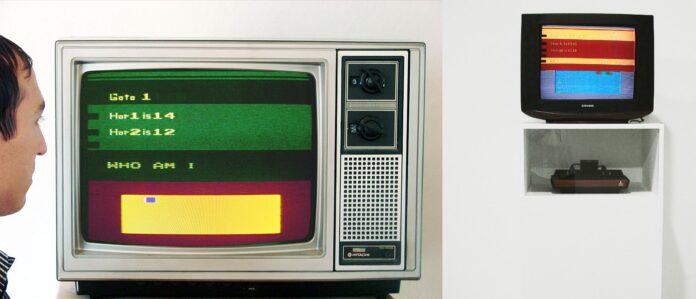Is the World Finally Catching Up?The Bonnier Gallery Presents |
Yucef Merhi: Open |
|
|
|
Yucef Merhi: Open |
|
On view Sept. 2 – Nov. 20 at The Bonnier Gallery |
|
|
|
“This new show will allow people to experience digital art that is of substance, as opposed to the speculative NFTs that seem to dominate that conversation,” says Grant Bonnier. |
|
|
|
In 1985, when pioneer digital artist Yucef Merhi was only eight years old and growing up in Caracas, he reverse-engineered his ATARI 2600 and turned it into a programmable computer. |
|
He used the Atari Video Computer System to produce generative videos based in language instructions. A leading art critic at the time saw this and proclaimed: “What you have created here, Yucef, will be considered a work of art in years to come.” |
|
Decades later, Merhi’s seminal creations would be exhibited at the New Museum in New York and would travel all over the world in international exhibitions, celebrated as the first works of art crafted from a videogame console. Watch a video that demonstrates one of these original 1985 works at youtu.be/zvcDaDcYo6g. |
|
One year later, at the age of nine, Merhi figured out how to calibrate the atomic clock of Venezuela, and the National Ministry of Defense commended him for achieving this breakthrough. |
|
|
From data hacking as protest art against totalitarianism and police brutality, to his new vision called Retrocycling that rescues obsolete tech devices from landfills . . . from perfecting a universal language as new source code for planetary awakening, to digital interventions that make poems come alive . . . throughout his 30+ year journey, the artist’s work has remained front and center in the current thinking about art, and especially digital art. |
|
Opening up a panoramic view of Merhi’s inner worlds, the new show Yucef Merhi: Open at The Bonnier Gallery captures the far-reaching consequence of his orbit around contemporary culture. For the viewer experiencing Merhi’s art, this often results in mind-expanding encounters with language. |
|
|
|
Pioneer Digital Artist Yucef Merhi has Opened Portals to the Leading Edge of Art and Technology for 30 years ‒ Is the World Finally Catching Up? |
|
|
|
|
The gallery show presents 15 works, from five different series that map out his creative diaspora. The show ushers in the eagerly anticipated return of Miami’s Art Basel season, and opens on September 2 at the Bonnier Gallery in Allapattah, Miami’s burgeoning art district. |
|
“This new show will allow people to experience digital art that is of substance, as opposed to the speculative NFTs that seem to dominate that conversation,” says Grant Bonnier, the curator of this show and owner of the Gallery. “Yucef Merhi has packed the equivalent of several lifetimes leading up to this critical mid-career point of his trajectory,” adds Bonnier. “Merhi is poised at the leading edge of the technology and art.” |
|
Yucef Merhi has produced bodies of work that engage a wide spectrum including poetry, facial recognition, artificial intelligence, sound, virtual reality, hacking, and retro video games. By ensuring that his works always connect with the warmth of human engagement through language, Merhi’s momentum continues ahead of the curve. |
|
|
Sorry, by Yucef Merhi, is one of the digital art works in the exhibition at the Bonnier Gallery. Pictured above is a photograph of the artwork when it was shown in Toronto as part of a public art installation series, called the Art in Transit – Luminato Festival. |
|
|
|
Selected by MIT Among the Leading Definers in Their Fields |
|
|
|
In addition to announcing the opening of this new show, the Gallery is also sharing the news from the Massachusetts Institute of Technology that Yucef Merhi was chosen for the MIT Open Documentary Lab ‒ opendoclab.mit.edu. |
|
After a rigorous selection process, Merhi is the only artist from Miami (and from all of Florida) to be selected among Fellows from around the world invited by MIT. |
|
They were chosen by MIT because they are considered to be definers in their fields ‒ leaders who deepen the impact and reach of innovative reality-based storytelling. Many of the winners combine influential, multiple roles as award-winning technologists, artists, academics, and activists. |
|
“Yucef Merhi has an impressive record as a border-crosser, a path-breaker, and hacker-extraordinaire,” says William Uricchio, the Founder and Principal Investigator of MIT Open Documentary Lab, and a Professor of Comparative Media Studies at MIT. “Merhi’s commitment to the environmental – as context, site of interrogation, and canvas (as his building-scale works demonstrate) – casts his work in a light that is defining the frontiers of the new documentary,” adds Uricchio. |
|
The international group includes Fellows from the U.S., Brazil, Colombia, the UK, and a number of expats too, from places like Iran and Algeria. MIT is a leading center for thinking about and developing technology, and this fellowship brings a humanistic, artistic, and critical dimension to that work, taking it on through new forms of documentary and creativity. |
|
|
ATARI Mindlink 1984. Image from MIT article by Yucef Merhi about his vision for Retrocycling: immerse.news/field-notes-why-its-time-for-retrocycling-c5381f922d81. |
|
For this MIT fellowship, Merhi will be investigating how to reduce the massive amounts of electronic waste on our planet that comes from obsolete technologies, by re-purposing outdated devices and transforming them into new artistic enterprises. |
|
This includes tons of discarded devices that have been filling up landfills for decades: video game consoles from the 1970s, TVs and slide projectors from the 1980s, cassette players, CD players, computer supplies, and VR equipment from the 1990s. |
|
|
Many of these discarded devices were designed and engineered to last longer than we expect from today’s appliances. Merhi is calling his new vision Retrocycling ‒ yucef.mit.edu/home. |
|
“I propose it is now time to ‘re-plan’ obsolescence moving forward,” says Yucef Merhi. “To start thinking about what we can do with the countless consumer electronics produced. Historic technologies have the power to align our actions and spark the curiosity of younger generations about new uses of old hardware.” |
|
|
|
The Tech Savant that Pioneered Digital Art |
|
|
|
“As a child, I felt I could actually communicate with these ATARI machines back in the 1980s. Electronic toys were so important to me because I built my reality with them,” says Merhi. |
|
|
Above – the artist Yucef Merhi. |
|
When he was 15, in 1992, Merhi was already consulting for AT&T, and created one of Venezuela’s first electronic communities by programming a Bulletin Board System (BBS). |
|
The child prodigy even built his country’s first-ever website (for a local Mayor who was also a Miss Universe). |
|
As time progressed, however, these whimsical connections between his home country and his art would take a more somber turn: reflecting the years ahead filled with turmoil and painful obstacles to restoring democracy. |
|
|
|
Hacking as Protest Art |
|
|
|
By 1998, Merhi had developed his first Datagram, a concept Merhi coined to visualize the movement of hacked information (he prefers the term “intercepted data” instead of hacking). |
|
Throughout the years, in protest of the dictatorship, Merhi intercepted Venezuelan government email accounts and databases, turning these revealed secrets into art that raises awareness. |
|
The Chavez regime in Venezuela feared Merhi because they realized he was able to access any server and any email platform in the country ‒ he even intercepted the emails of Hugo Chavez. The government in Venezuela stopped inviting Merhi to exhibit at museums and even blocked him from representing Venezuela at the Venice Biennale in 2013. Merhi was put on a cultural blacklist. |
|
|
No Fly Security, by Yucef Merhi (2018-2019). Intercepted data on laser paper. |
|
One of the works from his Datagram series in this show is a study for No Fly Security. This study was the starting point for what would later become a large-scale, immersive installation comprised of official reports, testimonies, and leaked data from the No Fly List, a list created and maintained by the U.S. federal government’s Terrorist Screening Center (TSC). |
|
The list identifies people who are prohibited from boarding commercial aircraft for travel within, into, or out of the United States. All the content has been kept secret until now. The work demonstrates evidence of the initial errors of the agency, as well as the struggle of many citizens from the U.S. and abroad whose identities have been mistaken. |
|
|
|
Fast-forward to now, and Merhi has reached international acclaim with major museum exhibitions, biennials, and gallery shows across the U.S., Latin America, Europe and Asia. |
|
He is the recipient of several awards, and his work is represented in the permanent collections of numerous museums and private collections. |
|
“Yucef Merhi is precisely the type of artist we should be focusing on coming out of the pandemic. He is like an antenna, with an uncanny ability to internalize the energy of others around him and reflect it in his work. He’s a beacon of hope ‒ what we all need right now,” says Grant Bonnier. View all of the works in this show at this link. |
|
|
|
Compassion: Responding to Our Turbulent Times |
|
|
|
The Gallery show’s largest installation, Compassion (2020), was created in 2020 during the pandemic and responds to the turbulent times we are living through. |
|
|
Compassion, by Yucef Merhi (2020). 5 CRT TVs, 5 Atari 2600 game consoles, custom Atari cartridges, directional sound system. Photo by Zachary Balber. |
|
The artist repurposed television sets that were manufactured for use in jails by incarcerated Americans ‒ reclaiming them with new, positive meaning. The viewer is drawn into the experience by their unusual transparent cases, originally meant to prevent prison-related smuggling. |
|
The installation Compassion features ATARIs that he programmed and connected to each of the television monitors. The ATARI cartridges interface to spell out one of Merhi’s epiphanies: Compassion is the Divine Compass, integrating language, video games, the sound of a Tibetan bell, and consciousness. Watch a video demonstrating this installation at vimeo.com/417787505. |
|
Watch the video of Compassion at vimeo.com/417787505. |
|
|
|
Artificial Stupidity |
|
|
|
Another work featured in this show, entitled Artificial Stupidity, tackles the decline in Venezuela through a rare use of humor. |
|
Merhi dissects politics with primitive notions of artificial intelligence. What appears to be a harmless throwback to vintage video arcade games turns out to be the cartoon-like head of Venezuelan dictator Nicolas Maduro chasing Venezuelan flags. |
|
Artificial Stupidity, by Yucef Merhi (2019). Metal stand, iPad, custom software. |
|
Every time Maduro’s head eats a flag, it becomes a poop emoji ‒ vimeo.com/582241974. “These patriotic symbols that have been hijacked by the dictatorship in Venezuela end up being transformed into digital excrement, alluding to the systematic destruction of the country,” says Yucef Merhi. |
|
Artificial Stupidity, by Yucef Merhi (2019). Metal stand, iPad, custom software. Watch the video at vimeo.com/582241974 |
|
|
|
Merhi has earned international acclaim throughout his career with major urban digital art installations, often because of his keen abilities to embed a feeling of human connection and the spirit of curiosity into the experiences. |
|
This includes a skyscraper’s 40,000 square foot building façade in downtown Sao Paulo wrapped with LEDs. |
|
It featured a vintage ATARI device from 1976 that translated spoken words and music from people on the street into gigantic, colorful geometric light patterns. Watch a video about this massive work: youtu.be/tW5voFrEWaI. |
|
C-240, by Yucef Merhi (2001-2014). LED building facade, modified Atari device, analogue-digital adapter w/software, 40,000 square feet. |
|
Download photos at: spaces.hightail.com/space/yXfBfxhbqQ Would you like to interview the artist Yucef Merhi? And interview the curator/gallery owner, Grant Bonnier? Media Contacts: Jose Lima & Bill Spring 305-910-7762 |
|
|
|
Racing the Beam |
|
|
|
Leading tech scholars have long recognized Yucef Merhi as an influencer and thought leader at the intersections of technology and art. |
|
In the groundbreaking book Racing the Beam (from The MIT Press), two of the country’s leading tech scholars (digital media professor Dr. Nick Montfort, and his co-author Dr. Ian Bogost, the academic and award-winning video game designer), also point to the avant-garde pathways that Merhi has blazed. They write about how these digital domains are “Blasting into the space of the museum and the worlds of art.” Racing the Beam develops a critical approach that examines the relationship between platforms (the systems underlying computing), and creative expression in digital media. |
|
|
In the recent book Video Games and the Global South (from Carnegie Mellon University: ETC Press, edited by Phillip Penix-Tadsen), Merhi’s pioneering contributions to digital art are valued. |
|
In the book’s chapter entitled The Nuances of Video Game Curation by Maria Lujan Oulton, she states: “Video games have managed to permeate all levels of society and are fast on their way to becoming the dominant medium of the 21st century, like the moving image was for the 20th century and the photograph was before both of them . . . So powerful is video games’ capacity to break down boundaries that even the normally hermetic and impenetrable art world has been drawn into their technological magic circle . . . The first approaches within the art field can be located in the early works of artists such as digital art pioneer Yucef Merhi, who began working with video games in the mid-1980s.” |
|
|
Yucef Merhi |
|
Dr. Christiane Paul is a renowned theoretician, and is the Whitney Museum of American Art’s Digital Art Adjunct Curator since 2000. She recognizes Merhi’s breakthrough work in her film documentary for Aspect: The Chronicle of New Media Art (watch an excerpt video featuring Merhi’s work at youtu.be/DQeHQ30eG30). Dr. Paul is widely known as the author of the book Digital Art, published by Thames & Hudson. She also serves as Chief Curator/Director of the Parsons School of Design/SJDC, and she is a Professor at The New School. |
|
|
|
Soulless Security |
|
|
|
Soulless Security also highlights the act of hacking as an instrument to create protest art. |
|
Merhi uses intercepted data to expose the full names and identity numbers of 50,000 officials from Venezuela’s notorious secret police (who wear hoods and use other means to hide their identities while committing atrocities on their fellow citizens). |
|
|
Soulless Security, by Yucef Merhi (2001-2014). Intercepted data on paper. |
|
The data is presented using the spatial ordering system initiated by the artist in 1998 (Datagram), which he created from the basic protocol of data transfer on the Internet. |
|
Once the data is intercepted, the information is laser printed and organized using a geometric pattern that fills the space with a dense textual mass. |
|
The Bonnier Gallery will exhibit detail sections of this work, which was bravely shown in its entirety in Caracas as a form of protest in 2017. The files were digitally “smuggled” into Venezuela and the large-scale installation mounted onto a wall. |
|
|
|
Why ATARI Means So Much to the Culture |
|
|
|
In his composition about Retrocycling, Yucef Merhi illuminates more about why ATARI means so much to the culture. “Although most people associate ATARI with classic video games such as Pong, Pac-Man, Space Invaders, and Asteroids, ATARI’s impact on our world is profound,” says Merhi. “Brilliant engineers, programmers, designers, and visionaries, including Steve Wozniak, Steve Jobs, Thomas G. Zimmerman, and Jaron Lanier all worked for ATARI.” |
|
|
“It is not widely known that ATARI’s founders also introduced the first widely used cross-platform game controller, conceived some of the world’s first Virtual Reality technology, and patented the first electronic music visualizer.” “Besides other giants such as AT&T and Xerox, ATARI was one of the pivotal tech companies that reshaped our notion of technology. In 1982 the corporation became the fastest-growing company in U.S. history,” adds Merhi. |
|
|
|
More About the Exhibition “Yucef Merhi: Open” |
|
|
|
|
The five series of works in this show are: Datagrams, ATARI, Digital Artworks, Perfect Language, and Poliverso. The exhibition’s 15 works and installations span the entire gallery space. Merhi is also creating a new work entitled Open, named after the title of this show, which will be exhibited for the first time. |
|
“The unifying element is language, in all of these bodies of work,” says Yucef Merhi. “Language carries energy. We are made out of language. We breathe language. And ultimately, we end up spending most of our time inside either the prism ‒ or the prison ‒ of language, depending on our intention.” adds Merhi. |
|
|
|
Perfect Language |
|
|
|
About his Perfect Language series, Merhi states: “While many of the world’s great thinkers have argued through the ages about the possible existence of a perfect language, only a few have tried to find it.” |
|
He created a sensorial metalanguage that can be applied to any language, making it automatically understandable to anyone. An example is the artist’s use of a thousand nails to depict the word nail in Korean. |
|
|
Perfect Language (Aluminum), by Yucef Merhi (2014). Eight letters made out of aluminum, aluminum shelf. |
|
In another work from this Perfect Language series, Merhi used eight letters made out of aluminum to depict the word aluminum in English. “I want people to go back to the primordial act of seeing the word itself,” says Merhi. |
|
Merhi lived and worked for an entire year in the ancient town of Antigua, Guatemala, researching Proto-Mayan language alongside archaeologists, historians, philologists, and epigraphists. |
|
There, he created works that tackle the atrocities of colonialism, called Perfect Language: Maya. When the Spaniards subjugated the Maya peoples they were intent on destroying their culture by erasing the Mayan visual language and making them dependent on the Latin alphabet instead. |
|
Some of the works by Merhi were carved in wood with the aid of master woodwork craftsmen. They symbolize the word “wood” in Mayan. “If we could disconnect from the occidental-colonizing view of art, we might be able to see and experience languages that are connected to the Divine,” says Merhi. |
|
|
Left to right: The master woodwork craftsmen that Yucef Merhi worked with in Guatemala, and the artwork entitled Perfect Language (Wood: Te #1), by Yucef Merhi (2014). Guatemalan cedar wood. |
|
|
The Poetic Clock 2.0 |
|
|
|
Merhi’s Digital Art series is represented on large-screen televisions facing each other. |
|
One of these works, entitled The Poetic Clock 2.0, is a digital time machine that transforms time into poetry and generates 86,400 different poems every 24 hours, displaying through language the movement of time. |
|
|
The artist’s reflection is captured in The Poetic Clock 2.0, by Yucef Merhi (2000). Computer, and custom software. |
|
Every time an hour changes, a new verse is digitally imprinted on screen, as the new first line of the poem. |
|
When a minute changes, a new verse pops up on the second line. The change of seconds is represented by the change of verses on the third line. The results are poems that mutate each second, minute and hour, continuously becoming another poem. |
|
|
Poliverso |
|
|
|
Merhi has even discovered an astonishing new literary form that he unlocked using the Fibonacci sequence, amplifying the meaning of words in a creative way that has never before been accomplished. |
|
While the Fibonacci sequence has been applied to music and artistic composition, no one has ever applied it to language in this manner ‒ Poliverso. |
|
|
Poliverso (detail) by Yucef Merhi (2012-2014). Wood boxes, glass and vinyl. |
|
The photo above shows how Merhi uses three-dimensional layering to illustrate his discovery: words that become two words, then become a sentence, the same way the golden ratio of the Fibonacci sequence causes similar patterns in nature. |
|
View all of the works in this show at this link. |
Help keep news FREE for our readers
Supporting your local community newspaper/online news outlet is crucial now more than ever. If you believe in independent journalism, then consider making a valuable contribution by making a one-time or monthly donation. We operate in rural areas where providing unbiased news can be challenging. Read More About Supporting The West Wales Chronicle
















































